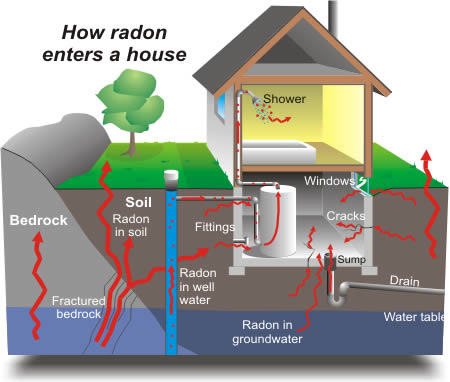Radon
What is radon?
Radon is a radioactive gas found naturally in the environment. It is colourless, odourless and tasteless. Radon is formed from the breakdown of uranium, found in soil, rock and groundwater.
Outdoors, the open air dilutes radon seeping from the ground to such low concentrations that it does not pose a concern. When radon enters an indoor space, such as a home, it can build up to high levels and pose a health concern to the people living there.
The Canadian Radon Guideline from Health Canada recommends the level of radon in the air of a home be no more than 200 Becquerels per cubic metre (Bq/m3) per year.
What are the health effects of radon?
- If inhaled, radon particles can damage lung tissue
- Radon exposure increases the risk of developing lung cancer
- Exposure to both radon and tobacco smoke significantly increases your risk of lung cancer
- Risk of lung cancer depends on:
- the level of radon in your house
- length of exposure
- whether you smoke
- exposure to second-hand tobacco smoke
How do I test for radon in my home?
Visit Take Action on Radon(external link) to find out how to test for radon in your home.
Radon Mitigation Program
Through collaboration with partners in the home building industry, Chief Building Officials of Niagara have implemented a program to mitigate radon for new construction. Beginning July 1, 2023, all new construction must comply with one of the following options:
- Rough-in soil gas pipe and mandatory Radon Soil Gas testing
- Radon Soil Gas barrier on the foundation walls and Radon Soil Gas barrier under the basement floor slab
- Radon Soil Gas barrier on the foundation walls and active sub-sab depressurization system
More questions?
Have specific questions about Radon that are not covered on this page? Reach out to the Chief Building Official directly.

Radon is harmless outdoors because it dissipates in outdoor air. In buildings, radon can seep in and accumulate undetected through areas where the house comes in contact with the soil. Possible entry points into include cracks in foundation walls and floor slabs, construction joints, gaps around service pipes, support posts, window casements, floor drains, sumps or cavities inside walls, dirt floors etc.
Source: Natural Resources Canada



 Subscribe to this page
Subscribe to this page